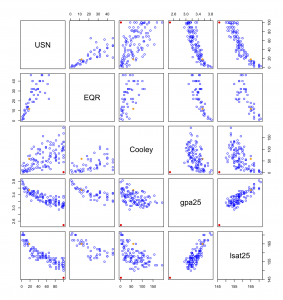Ranking universities
With the PBRF research assessments happening this year, there is sure to be another round next year of universities using the results in creative ways to make themselves look good. When you have a large number of variables to take into account, it’s easy to come up with apparently-reasonable weightings that make one institution look better than another.
A dramatic example of this is ratings of US law schools. The most widely-known rankings are from US News, and there’s another popular set from Brian Leiter, a professor at University of Texas, which aims to focus only on quality of education. A third set is published by the slightly unusual Thomas J. Cooley School of Law. There is definitely correlation in the top rankings: for example, Harvard tops the Cooley rankings and is second for the other two. The graph below (click to embiggen) shows the three rankings and the lower quartile of GPA and LSAT results for some top colleges (I got the data from here, and added the Cooley rankings by hand)
You were wondering perhaps about the two colored dots?
The orange dot is University of Texas, Prof. Leiter’s employer. His ranking for his own school is between the other two rankings. The red dot is Thomas J. Cooley law school. The US News rankings don’t include them in the top 100 (they don’t quantify past the first 100), but their own ranking makes them second in the US, behind only Harvard.
Thomas Lumley (@tslumley) is Professor of Biostatistics at the University of Auckland. His research interests include semiparametric models, survey sampling, statistical computing, foundations of statistics, and whatever methodological problems his medical collaborators come up with. He also blogs at Biased and Inefficient See all posts by Thomas Lumley »
